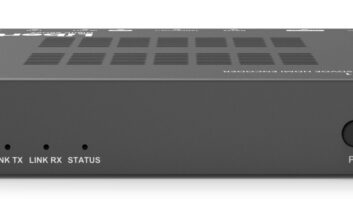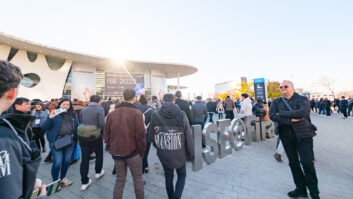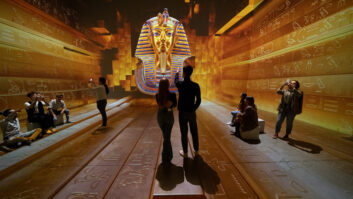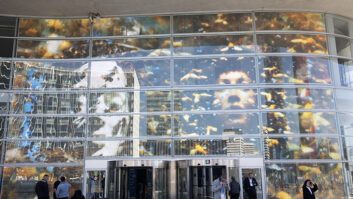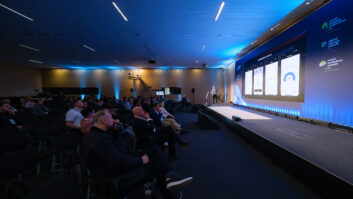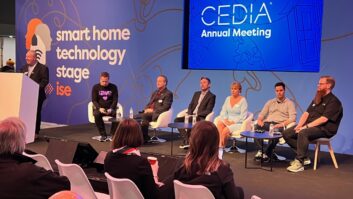Integrated Systems Europe 2011 exceeded just about everyone’s expectations for visitor numbers. The final total of 34,870 was even at the high end of the various guesses made ahead of the show by the staff of organisers Integrated Systems Events, and represented a leap of 22% on the 2010 attendance.
So why did the show draw such large numbers? Of course there was more to see than ever, with around 715 exhibitors, 150 of them new to the event. There was also a stronger conference offering, with three conferences taking place the day before the exhibition began. One of these, the Wainhouse Visual Communications Summit, was a previously existing event which the organisers decided to hold at ISE because of the popularity of the tradeshow. The event has also increased its ties with industry associations of all kinds, with AVnu Alliance, ISCE and the AV Users’ Group being among those present at the show for the first time.
The organisers’ research highlights the that show is also drawing a wider cross-section of attendees than in previous years. Earlier ISEs tended to draw a more managerial audience, but now engineer-level delegates are coming as well. This has fed into the education programme at ISE 2011, which was stronger than ever – although demand for education at ISE still lags a long way behind InfoComm’s show in the US every summer.
The organisers also point to greater representation from end users and specifiers – due in part to hosted buyer programmes that make it easier for potential equipment purchasers to attend the show.
All of these developments serve to increase ISE’s critical mass, so that it draws not only people who directly want to see what’s on offer on the showfloor or in the conference and education sessions, but also people who simply want to meet their peers. Exhibitors also noted a larger number of end-user visitors at the show this year. More than ever, it’s a place where the industry meets.
Will the show continue to grow? There is every reason to believe it will, on both the visitor front and the exhibition front. More than 100% of the 2011 floor area had been sold for 2012 as the show ended – and one can’t help but wonder if the extra hall that has been added for next year will be enough, particularly if the trend for existing exhibitors to increase the size of their stands continues. Also, will a larger show necessitate a longer show? Although the dates for ISE 2012 have been announced as 31 January to 2 February, ISE tells us that the duration of the show remains a topic for discussion at Board and Advisory Board level.
@page_break@
3D
In Hall 11, the 3D Theatre provided an opportunity to learn more about 3D equipment as well as view high-quality 3D content. The programme was organised by Lutz Mohr of the 3D Competence Centre, who told The ISE Daily: “From my point of view, 2011 could well be the year that stereoscopic 3D really begins to establish itself in the mainstream. It can touch all AV markets, because it brings so many practical advantages in so may applications.”
Looking round the showfloor, it was hard to disagree with him, as there were almost too many types of 3D-related products on display to count. Hyundai presented a 3D videowall, as did Lang and Samsung. Glasses-free 3D was on display from MMD (based on Philips technology), Zero Creative and Avnet Embedded. There were combined active and passive 3D glasses from Volfoni. There were 3D plasmas from Panasonic, including a 152in model. Toshiba exhibited a display that showed 3D and 2D simultaneously – the naked eye saw only the 2D image if one stood beyond a certain distance from the screen. There were 3D projectors for the home (such as from Runco), 3D projectors for pro AV (Christie, projectiondesign and others) and projectors that converted 2D content to 3D on the fly (Vivitek, Wolfvision/JVC). There were 3D LED TVs from Samsung, and 3DTV extenders from Aavara. There was even software that enables your 3D avatar to interact with CG characters in real time (GestureTek).
@page_break@
Digital signage
Another large and growing area of the show is digital signage. “If we only look at the dedicated digital signage area of ISE, it is the largest digital signage exhibition in Europe,” Mike Blackman, Integrated Systems Events managing director told us ahead of the show. “When we add all the display companies, such as Sharp and LG, that are not in that area, there’s no comparison.”
DiSCO, the Digital Signage Conference, attracted 20% more attendees than the corresponding event last year. The overriding impression from the conference was that the relative immaturity of the market (compared with many other markets served by ISE) meant that there were significant opportunities, but also difficulties. As Lars Peters (pictured) of ECE flatmedia said: “We are a new industry and we still have to prove to agencies that what we offer really works.”
The dedicated digital signage area of the showfloor spread out from its traditional home in Hall 12 to occupy a large area of Hall 10 as well. With more than 140 digital signage-related stands at the show, there was a lot to see on the showfloor, be it displays, videowalls, freestanding kiosks, touchscreens, media servers and players, processors or software.
One notable trend was a proliferation of solutions for small and medium-sized businesses. For instance, HP and Scala joned forces with the QuickStart system, which at its simplest consists of a Scala player running the Windows Embedded operating system and an HP display. Users create content online using web-based templates, so that content can be produced and updated from anywhere in the world. At this point, I’d like to offer grateful thanks to both companies for lending Installation Europe a QuickStart system to use on our stand – it certainly helped us to create an eye-catching rolling presentation, which attracted many favourable comments.
Other software being shown for the lower end of the DS market included SpinetiX’s Fusion, C-nario’s C-sign, ReQuest’s Harmony software-as-a-service offering (distributed by BMB) and DISE’s Dise LS.
@page_break@
Displays
As ever at ISE, it tends to be the large displays that grab the eye as one walks the showfloor. One of the most arresting displays was on the Sharp stand, which was the site of an immersive five-wall display called The Cube. This was made up of 64 separate 60in LCD monitors, with seams of just 6.5mm.
Two companies that displayed prototype display technologies at ISE last year came back with commercial versions. Mitsubishi Electric had the Diamond Vision OLED, the only commercially available large-screen OLED display. Made from tiles 384mm square and 99mm deep, it’s said to offer around three times the light output and twice the contrast ratio of a comparable LED screen. It can also be used to create convex curved screens, as a hanging cylindrical display demonstrated. The minimum achievable radius of curvature is around 0.5m.
A display technology that can be used to build concave screens – as well as more conventional flat ones – is Prysm’s LPD (pictured), which was displayed as a full production version at ISE 2011 following the behind-closed-doors preview last year. With a scarcely visible join between tiles and power consumption up to 75% less than some competing technologies, this has to be a technology with a future.
Another notable display was NanoLumens’ lightweight, flexible LED screen, which was initially developed to provide an alternative to cross-track projection. Offered by UK distributor PSCo in a 112in size (weighing 41kg), custom designs of any size or shape are promised for the future.
@page_break@
Digital editions
The sheer scope of ISE is such that a review like this can do little more than scratch the surface of what was there – we’ve not really touched on residential systems, pro audio or a load of other technology areas. Fortunately, the three editions of The ISE Daily – the redesign of which this year attracted compliments from many people – are available online as digital editions. These are exact replicas of the printed magazine, and are text searchable. They will remain there until ISE 2012 – which, as of the start of this month, is just 337 days away! It’ll be here before you know it.
